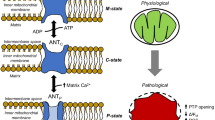Abstract
Hypoxia hampers ATP production and threatens cell survival. Since cellular energetics tightly controls cell responses and fate, ATP levels and dynamics are of utmost importance. An integrated mathematical model of ATP synthesis by the mitochondrial oxidative phosphorylation/electron transfer chain system has been recently published (Beard, PLoS Comput Biol 1(4):e36, 2005). This model was validated under static conditions. To evaluate its performance under dynamical situations, we implemented and simulated it (Simulink®, The Mathworks). Inner membrane potential (ΔΨ) and [NADH] (feeding the electron transfer chain) were used as indicators of mitochondrial function. Root mean squared error (rmse) was used to compare simulations and experiments (isolated cardiac mitochondria, Bose et al. J Biol Chem 278(40):39155–39165, 2003). Steady-state experimental data were reproduced within 2–6%. Model dynamics were evaluated under: (i) baseline, (ii) activation of NADH production, (iii) addition of ADP, (iv) addition of inorganic phosphate, (v) oxygen exhaustion. In all phases, except the last one, ΔΨ and [NADH] as well as oxygen consumption, were reproduced (within 10, 7 and 12%, respectively). Under anoxia, simulated ΔΨ markedly depolarized (no change in experiments). In conclusion, the model reproduces dynamic data as long as oxygen is present. Anticipated improvement by the inclusion of ATP consumption and explicit Krebs cycle are under evaluation.




Similar content being viewed by others
Abbreviations
- ATP:
-
Adenosine-5′-triphosphate, the energetic currency of the cell
- ADP:
-
Adenosine-5′-diphosphate (ADP and Pi are the substrates for the ATP-synthase)
- AMP:
-
Adenosine-5′-monophosphate
- Complex I:
-
NADH dehydrogenase, EC 1.6.5.3, or NADH:(ubi)quinone oxidoreductase, first respiratory complex of the electron transfer chain, catalyzes the transfer of NADH electrons to (oxidized) ubiquinone and translocates four protons to the mitochondrial intermembrane space
- Complex III:
-
(ubi)quinone:cytochrome c oxidoreductase, EC 1.10.2.2, third complex of the electron transport chain, transfers electrons from (reduced) ubiquinol to (oxidized)cytochrome c (two protons translocated in the process)
- Complex IV:
-
Cytochrome c oxidase, EC 1.9.3.1, the last “respiratory complex”, catalyzes the transfer of electrons (four) from cytochrome c to molecular oxygen, producing two molecules of wate (translocating four protons)
- Cytochrome c :
-
Cyt c is a small, soluble protein, loosely associated with the (outer aspect of the) mitochondrial inner membrane; its redox couple plays an essential role in the electron transfer chain (between complex III and complex IV)
- ΔΨ:
-
Transmembrane electrical potential difference across the mitochondrial inner membrane
- EC:
-
Enzyme Commission number (see url http://www.chem.qmul.ac.uk/iubmb/enzyme/)
- Pi:
-
Inorganic phosphate
- NADH (+H+):
-
Nicotinamide adenine dinucleotide coenzyme (reduced form)
- ODE:
-
Ordinary differential equations
- Ubiquinone:
-
The oxidized form of the ubiquinone/ubiquinol couple, involved as a redox cofactor in the electron transfer chain.
- url:
-
Universal resource locator
References
Beard DA (2005) A biophysical model of the mitochondrial respiratory system and oxidative phosphorylation. PLoS Comput Biol 1(4):e36
Bose S, French S, Evans FJ, Joubert F, Balaban RS (2003) Metabolic network control of oxidative phosphorylation: multiple roles of inorganic phosphate. J Biol Chem 278(40):39155–39165
Boutilier RG (2001) Mechanisms of cell survival in hypoxia and hypothermia. J Exp Biol 204(Pt 18):3171–3181
Cadenas S, Echtay KS, Harper JA, Jekabsons MB, Buckingham JA, Grau E, Abuin A, Chapman H, Clapham JC, Brand MD (2002) The basal proton conductance of skeletal muscle mitochondria from transgenic mice overexpressing or lacking uncoupling protein-3. J Biol Chem 277(4):2773–2778
Cairns CB, Walther J, Harken AH, Banerjee A (1998) Mitochondrial oxidative phosphorylation thermodynamic efficiencies reflect physiological organ roles. Am J Physiol 274(5 Pt 2):R1376–R1383
Chance B, Williams GR (1956) The respiratory chain and oxidative phosphorylation. Adv Enzymol 17:65–134
Cortassa S, Aon MA, Marban E, Winslow RL, O’Rourke B (2003) An integrated model of cardiac mitochondrial energy metabolism and calcium dynamics. Biophys J 84:2734–2755
De Groot H, Rauen U (2007) Ischemia-reperfusion injury: processes in pathogenetic networks: a review. Transplant Proc 39(2):481–484
Devin A, Rigoulet M (2007) Mechanisms of mitochondrial response to variations in energy demand in eukaryotic cells. Am J Physiol 292(1):C52–C58
Diederichs F (2006) Mathematical simulation of membrane processes and metabolic fluxes of the pancreatic beta-cell. Bull Math Biol 68(7):1779–1818
Hulbert AJ, Turner N, Hinde J, Else P, Guderley H (2006) How might you compare mitochondria from different tissues and different species? J Comp Physiol B 176:93–105
Korzeniewski B, Zoladz JA (2001) A model of oxidative phosphorylation in mammalian skeletal muscle. Biophys Chem 92(1–2):17–34
Matsuoka S, Sarai N, Jo H, Noma A (2004) Simulation of ATP metabolism in cardiac excitation–contraction coupling. Progr Biophys Mol Biol 85:279–299
Mitchell P, Moyle J (1967) Chemiosmotic hypothesis of oxidative phosphorylation. Nature 213:137–139
Rossignol I, Malgat M, Mazat JP, Letellier T (1999) Threshold effect and tissue specificity: implication for mitochondrial cytopathies. J Biol Chem 274(47):33426–33432
St-Pierre J, Brand MD, Boutilier RG (2000) Mitochondria as ATP consumers: cellular treason in anoxia. Proc Natl Acad Sci USA 97(15):8670–8674
Yugi K, Tomita M (2004) A general computational model of mitochondrial metabolism in a whole organelle scale. Bioinformatics 20(11):1795–1796
Acknowledgements
We wish to thank Dr Dan Beard, from the Biotechnology and Bioengineering Centre (Medical College of Wisconsin, Milwaukee, USA) for helpful comments and precisions about his model. We thank Pr Jean-Pierre Mazat (Inserm U688, Université de Bordeaux, France) for experimental data. This work was supported by the CNRS (PH), the INSERM, and the Faculty of Medicine and Pharmacy (University of Poitiers).
Author information
Authors and Affiliations
Corresponding author
Rights and permissions
About this article
Cite this article
Guillaud, F., Hannaert, P. Dynamic Simulation of Mitochondrial Respiration and Oxidative Phosphorylation: Comparison with Experimental Results. Acta Biotheor 56, 157–172 (2008). https://doi.org/10.1007/s10441-008-9035-z
Received:
Accepted:
Published:
Issue Date:
DOI: https://doi.org/10.1007/s10441-008-9035-z




